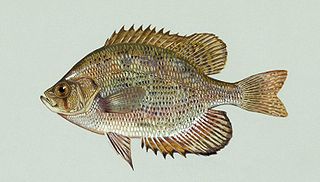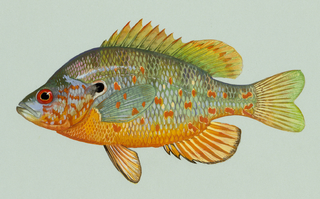
Centrarchidae, better known as sunfishes, is a family of freshwater ray-finned fish belonging to the order Centrarchiformes, native only to North America. There are eight universally included genera within the centrarchid family: Lepomis, Micropterus, Pomoxis (crappies), Enneacanthus, Centrarchus, Archoplites, Ambloplites, and Acantharchus. A genetic study in 2012 suggests that the highly distinct pygmy sunfishes of the genus Elassoma are also centrarchids.

The bluegill, sometimes referred to as "bream", "brim", "sunny", or, as is common in Texas, "copper nose", is a species of North American freshwater fish, native to and commonly found in streams, rivers, lakes, ponds and wetlands east of the Rocky Mountains. It is the type species of the genus Lepomis, from the family Centrarchidae in the order Centrarchiformes.

Lepomis or true sunfish is a genus of North American freshwater fish from the family Centrarchidae in the order Centrarchiformes. The generic name Lepomis derives from the Greek λεπίς ("scale") and πῶμα. The genus' most recognizable species is perhaps the bluegill.

The pumpkinseed, also referred to as sun perch, pond perch, common sunfish, punkie, sunfish, sunny, and kivver, is a small to medium–sized freshwater fish of the genus Lepomis, from the sunfish family (Centrarchidae) in the order Centrarchiformes. It is endemic to eastern North America.

Elassoma is a genus of freshwater fish, the only member of subfamily Elassomatinae of the sunfish family Centrarchidae in the order Perciformes. It is sometimes classified as a separate family, the Elassomatidae, in a monotypic suborder, Elassomatoidei, in Perciformes. The type species is E. zonatum, the banded pygmy sunfish. The Elassomatinae are known collectively as pygmy sunfishes, but are considered by some authorities not to be true sunfishes, which are members of the family Centrarchidae. Some researchers believe they are related to sticklebacks and pipefishes rather than Perciformes, though genetic research strongly implies a close relationship with the centrarchids. Currently the Integrated Taxonomic Information System classifies them in the family Elassomatidae rather than Centrarchidae.

The warmouth is a freshwater fish of the sunfish family (Centrarchidae) that is found throughout the eastern United States. Other local names include molly, redeye, goggle-eye, red-eyed bream, and strawberry perch.

The rock bass, also known as the rock perch, goggle-eye, red eye, and black perch, is a freshwater fish native to east-central North America. This red-eyed fish is a species of freshwater fish in the sunfish family (Centrarchidae) of order Centrarchiformes and can be distinguished from other similar species by the six spines in the anal fin.

The shadow bass is a species of freshwater fish in the sunfish family (Centrarchidae) of order Centrarchiformes. It is endemic to southeastern United States of America.

The redbreast sunfish is a species of freshwater fish in the sunfish family (Centrarchidae) of the order Centrarchiformes. The type species of its genus, it is native to the river systems of eastern Canada and the United States. The redbreast sunfish reaches a maximum recorded length of about 30 centimetres (12 in).

The green sunfish is a species of aggressive freshwater fish in the sunfish family (Centrarchidae) of order Centrarchiformes. The green sunfish does not always grow large enough to be an appealing target for anglers, but it is kept as an aquarium fish by hobbyists. They grow to be 3–6 inches (7.6–15.2 cm) long on average, but can achieve a length of 12 inches (30 cm).

The longear sunfish is a freshwater fish in the sunfish family, Centrarchidae, of order Centrarchiformes. It is native to the area of eastern North America stretching from the Great Lakes down to northeastern Mexico. The longear sunfish reaches a maximum recorded length of about 24 cm (9.4 in), with a maximum recorded weight of 790 g (1.74 lb). Most do not live beyond six years. The longear sunfish is quite colorful, with an olive to rusty-brown back, bright orange belly and vermiculate blue-green bars on the sides of its head, the latter two features most pronounced in breeding males. A unique characteristic of longear sunfish is their elongated operculum flap, giving an appearance of a "long ear". It is black and often has a white margin. The pectoral fin is relatively short and would not reach the snout if it were reflected anteriorly. In breeding males, iridescent blue spots develop on the dorsum and sides and the fin membranes turn orange in all fins except the ventral ones, which may be blue to black, and the pectoral ones. Lepomis megalotis can be distinguished from closely related dollar sunfish L. marginatus by a greater number of cheek scale rows, by having one to two additional pectoral fin rays and by the slope of the opercular flap, which is distinctly upward in L. marginatus but is closer to horizontal in males of L. megalotis, although female and subadult L. megalotis may have upward slanting opercular flaps.

The redear sunfish, also known as the shellcracker, Georgia bream, cherry gill, chinquapin, improved bream, and sun perch, is a freshwater fish in the family Centrarchidae and is native to the southeastern United States. Due to its popularity as a sport fish, it has been widely introduced across North America.

The orangespotted sunfish is a North American species of freshwater fish in the sunfish family (Centrarchidae) of order Centrarchiformes. These fish are widely distributed across the middle and eastern United States, from the Rocky Mountains to the east, from the Great Lakes south into the Gulf Coast. The orangespotted sunfish is ecologically unique and thrives in turbid, shallow systems that have few predators and low oxygen contents. The species prefers vegetated areas in sluggish backwaters or lakes, and can also be found in turbid rivers. The orangespotted sunfish can extend its range in lower-quality waters, which is not characteristic of other sunfish. Orangespotted sunfish vary in total length and age for different river basin originations, but can be found to live four to seven years, and recorded lengths are up to 15 cm (5.9 in).

The golden topminnow is a fish of the genus Fundulus and is a United States native fish mostly distributed throughout the southeast, ranging from Kentucky and Ohio south into Florida. Although it has such a wide distribution throughout the south, the habitats and micro-habitats that it occupies do not differ much from one area of distribution to others. The golden topminnow is a small surface feeding fish that tends to reproduce late in the spring season and on into the early parts of the summer, and although the fry reach maturity fairly quickly the longevity of the golden topminnow is quite short. Because the golden topminnow is lower in the trophic level and is a small fish, it primarily feeds on small and/or drifting organisms at, or near the surface of, vegetated areas. This particular topminnow is not currently listed as an endangered species, nor does it have any particular type of management plan.

The banded pygmy sunfish, Elassoma zonatum, is a species of pygmy sunfish endemic to the United States, where it is found from Indiana and Illinois to Texas to the Atlantic coast. It prefers densely vegetated bodies of slow-moving water. This species can reach 4.7 cm (1.9 in) in total length, though most do not exceed 3.5 cm (1.4 in).

The spotted sunfish, also known as a stumpknocker, is a member of the freshwater sunfish family Centrarchidae and order Centrarchiformes. The redspotted sunfish, redear sunfish and pumpkinseed sunfish are its closest relatives. Lepomis punctatus is olive-green to brown in color with black to reddish spots at the base of each scale that form rows of dots on the side. The scientific name punctatus refers to this spotted pattern. It was first described in 1831 by Valenciennes.

The redspotted sunfish, also known as a stumpknocker, is a species of freshwater ray-finned fish, a sunfish from the family Centrarchidae which is native to the United States. The redspotted sunfish was previously considered to be a western subspecies of spotted sunfish but was distinguished as a separate species by Warren in 1992.

The bantam sunfish is a species of freshwater fish in the genus Lepomis common throughout Louisiana, in extreme southeastern Texas, in southern Arkansas, and in a few places in western Kentucky and western Tennessee.

The northern sunfish is a freshwater fish in the sunfish family (Centrarchidae). It is endemic to northern North America. Lepomis peltastes was previously recognized as a subspecies of longear sunfish, but is now widely considered a distinct species.



















